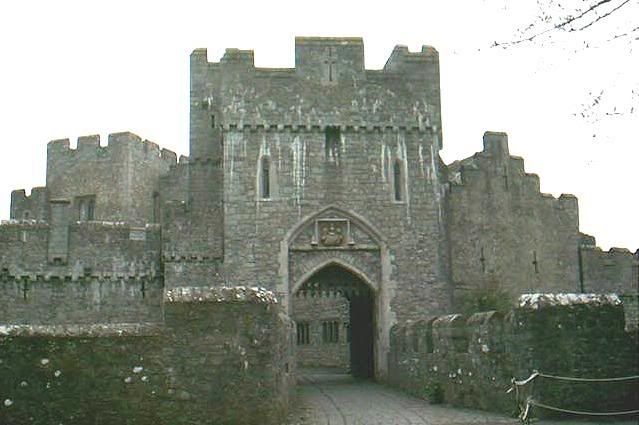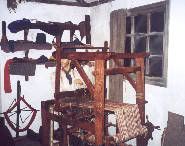H.Johnson
One Too Many
- Messages
- 1,562
- Location
- Midlands, UK
For me one of the most fascinating things about tweed is its association with a particular part of the er...British Isles*.
As with local foods and drinks (e.g. cheeses, beers, ciders, apples) It is interesting to visit the places where such tweeds used to be made. You get to see a lot of 'outlet villages', executive housing developments and trendy wine bars, but you also find that tweed is still being made, or at least there are relics of its production that are worth recording. Finding out a tweed's roots is what I call tweed exploration. I'll start the thread and see if anyone joins in with their own experiences...
Now, I have had through my hands the more commonly seen Irish, Scottish and English tweeds as well as some of the rarer ones that you rarely see anymore, including Devon and Cheshire. Over fifty years of wearing it, I thought I had seen some great tweed. Until, that is I bought a three piece number in herringbone Manx Tweed from Baron Kurtz.
This is, quite simply, tweed in another dimension. The exremely pure water and the natural tones of the native Loaghtan fleece make for an exceptional fabric. It far exceeds any other tweed I have seen for its brightness, its texture and the irresistable green motes that fleck its surface. It was woven by Moore's at the Tynwald Mills, St. John's, I-o-M. I had heard good things about their work but having finally handled an example I had to go see where it was made and, if possible, to find examples of other Manx tweeds in their native environment. So, wearing suitably unobtrusive expedition clothing (a 3-piece Norfolk suit in Derby tweed) I set off for Liverpool and the Steam Packet Company landing stage...
My initial expectation that the streets of my destination would be full of shops selling all manner of clothing in Manx tweed was to be disappointed. True, there we lots of places selling T-shirts with every conceivable thing relating to motorcycle road racing, but they weren't exactly what I was looking for. An enquiry led me to St. George's Mills at Laxey, where tweed production was restarted at around the time that the Tynwald Mills were running down. My excitement at visiting was to be rather misplaced. Tweed was being produced (you can buy it over the Interweb) but the proprietors had come from Scotland (very near to Aero Leather's premises) and they seemed to concentrate on 'Manx tartan' (about which I am not qualified to comment). Certainly tweed woven in a Manx mill, but not what I would call traditional Manx tweed.
So, on the 'bus to St. John's, the location of the 'oldest parliament in the world', and disappointment. Tynwald Mills is a 'craft centre'. It sells the same as every other 'outlet' you will find where there used to be a factory. there were just two notices by the stream running past the coffee shop that announced that 2 million yards of tweed had been woven there between the 1920s and the 1980s. They could have added that they supplied the Duke of Kent with his tweed, but perhaps they had forgotten that...
C-mon, let's share our tweed searching experiences...
---------------------------------------------------------------
* A geographical, rather than political, term that includes England, Wales, Scotland, Northern and Southern Island, the Isle of Man, Isle of Wight, The Scilly Isles, Lundy, Skomer and Skokholm, Anglesey, The Farnes and Lindisfarne, Arran, The Inner and Outer Hebrides, Shetland Isles, Orkney Isles and any other island whose inhabitants I may have enraged by either leaving them out or including them.
As with local foods and drinks (e.g. cheeses, beers, ciders, apples) It is interesting to visit the places where such tweeds used to be made. You get to see a lot of 'outlet villages', executive housing developments and trendy wine bars, but you also find that tweed is still being made, or at least there are relics of its production that are worth recording. Finding out a tweed's roots is what I call tweed exploration. I'll start the thread and see if anyone joins in with their own experiences...
Now, I have had through my hands the more commonly seen Irish, Scottish and English tweeds as well as some of the rarer ones that you rarely see anymore, including Devon and Cheshire. Over fifty years of wearing it, I thought I had seen some great tweed. Until, that is I bought a three piece number in herringbone Manx Tweed from Baron Kurtz.
This is, quite simply, tweed in another dimension. The exremely pure water and the natural tones of the native Loaghtan fleece make for an exceptional fabric. It far exceeds any other tweed I have seen for its brightness, its texture and the irresistable green motes that fleck its surface. It was woven by Moore's at the Tynwald Mills, St. John's, I-o-M. I had heard good things about their work but having finally handled an example I had to go see where it was made and, if possible, to find examples of other Manx tweeds in their native environment. So, wearing suitably unobtrusive expedition clothing (a 3-piece Norfolk suit in Derby tweed) I set off for Liverpool and the Steam Packet Company landing stage...
My initial expectation that the streets of my destination would be full of shops selling all manner of clothing in Manx tweed was to be disappointed. True, there we lots of places selling T-shirts with every conceivable thing relating to motorcycle road racing, but they weren't exactly what I was looking for. An enquiry led me to St. George's Mills at Laxey, where tweed production was restarted at around the time that the Tynwald Mills were running down. My excitement at visiting was to be rather misplaced. Tweed was being produced (you can buy it over the Interweb) but the proprietors had come from Scotland (very near to Aero Leather's premises) and they seemed to concentrate on 'Manx tartan' (about which I am not qualified to comment). Certainly tweed woven in a Manx mill, but not what I would call traditional Manx tweed.
So, on the 'bus to St. John's, the location of the 'oldest parliament in the world', and disappointment. Tynwald Mills is a 'craft centre'. It sells the same as every other 'outlet' you will find where there used to be a factory. there were just two notices by the stream running past the coffee shop that announced that 2 million yards of tweed had been woven there between the 1920s and the 1980s. They could have added that they supplied the Duke of Kent with his tweed, but perhaps they had forgotten that...
C-mon, let's share our tweed searching experiences...
---------------------------------------------------------------
* A geographical, rather than political, term that includes England, Wales, Scotland, Northern and Southern Island, the Isle of Man, Isle of Wight, The Scilly Isles, Lundy, Skomer and Skokholm, Anglesey, The Farnes and Lindisfarne, Arran, The Inner and Outer Hebrides, Shetland Isles, Orkney Isles and any other island whose inhabitants I may have enraged by either leaving them out or including them.






